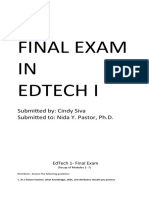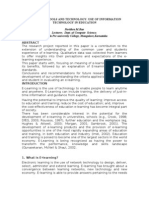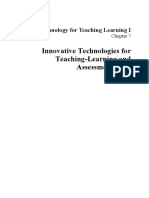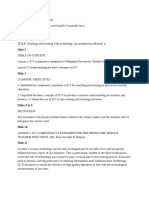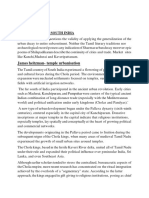Integration of The Internet To Support Learning
Integration of The Internet To Support Learning
Uploaded by
Sundusil ArsyiCopyright:
Available Formats
Integration of The Internet To Support Learning
Integration of The Internet To Support Learning
Uploaded by
Sundusil ArsyiOriginal Title
Copyright
Available Formats
Share this document
Did you find this document useful?
Is this content inappropriate?
Copyright:
Available Formats
Integration of The Internet To Support Learning
Integration of The Internet To Support Learning
Uploaded by
Sundusil ArsyiCopyright:
Available Formats
Nama:Maulfi Muhammad Yusuf 205180103
Locall:6c
Chapter10
Integration of the Internet to Support Learning
In this chapter, we examined uses of the Internet to en-hance learning. Applications of the Internet
in educationcan be put into one of four broad categories; communication, information retrieval,
information publishing, and
application platform. Asynchronous forms of communi-
cation include e-mail and mailing lists, while synchronous
forms of communication include instant messaging and
chat. These technologies allow for rapid communication
between individuals or groups. Students and teachers canretrieve text, images, audio, and video
information from
the World Wide Web. Structured approaches for integrat-
ing information retrieval in educational lessons include
scavenger hunts and WebQuests. The Internet can also be
used for information publishing. Using Web authoring
software, blogs, or wikis, students and teachers can cre-
ate materials that can be accessed by others on the Inter-
net. Finally, Web-based applications make the Internet a
platform for cloing wvork of all kinds.
Teachers and stuclents need to be aware of issuesrelated to the use of the lnternet in the classroom.
Copy-
right laws apply to materials on the Internet just as they
do to materials in Other melia. Security and information
Chapter 11
Integration of Distance
Education to Support
Learning
In this chapter, we examined education, any or-
ganized instructional program in which the teacher and
learners àre physically separated. Distance education
addresses problems of educational access caused by dis-
tance, disability, or work and family obligations, among
others. Technology is often used in distance education
to facilitate communication berween teacher and learn-ers. We examined the characteristics of
three categories
of distance education technologies: audio-based, video-
based, and computer-based.
Planning is especially important for successful dis-
tance education. When planning for a distance education
lesson, you should ake advantage of the benefits of the
technology, understand the characteristics of distance ed-
ucation learners, prepare for the experience, and avoid
problems and pitfalls. Examples of distance education
were presented, and strategies for implementing distance
education were described. Assessment of student perfor-
mance at a distance was considered, and utilization
guidelines for distance education were presented.
Issues associated with distance education were
also presented. These issues include copyright, the need
for support, and issues related to policy.
Chapter 12
Evaluation of Instructional
Materials and the
Assessnment of Student
Learning
In this chapter, we described evaluation as a "cycle of
continuous improvement" in which you can use a vari
ety of evaluation techniques before, during, and after a
learning experience. We discussed different techniques
to evaluate both how much students have learned (in-
cluding both standard and alternative assessment tech
niques) and the effectiveness of your instruction. For
each technique, we described its advantages and of-
fered a set of practical guidelines for its use.
Chapter 13
ntegrating Technology
Issues, Trends,
and Horizons
Today, instructional design, educational media, and ed-
ucational computing are all established disciplines and
are converging through the capabilities of the computer.
Media are becoming digital, and the computer offers
new capabilities for planning, implementing, and evalu-
ating instrnuction. \While the typical school of today has a
You might also like
- Interior Lighting DesignDocument4 pagesInterior Lighting DesignEvon ChayNo ratings yet
- The Virtual Classroom: The Role of ICT in Open and Distance LearningDocument5 pagesThe Virtual Classroom: The Role of ICT in Open and Distance LearningijccetNo ratings yet
- Annex-2 Ecampus OdsDocument54 pagesAnnex-2 Ecampus OdsMuhammad ibrarNo ratings yet
- Impact of Social Network Based Learning: Cope of Uture DvancementsDocument4 pagesImpact of Social Network Based Learning: Cope of Uture Dvancementsrozeny2kNo ratings yet
- Revised Standard Five of The National Educational Technology Standards 2Document8 pagesRevised Standard Five of The National Educational Technology Standards 2api-270732603No ratings yet
- Chapter OneDocument6 pagesChapter OneTobiloba TemitopeNo ratings yet
- Irene Berlian SemproDocument17 pagesIrene Berlian SemproEvaocca EvionenzaNo ratings yet
- The Development of Instructional Media On Physics Subject To Increase The Class EffectivenessDocument5 pagesThe Development of Instructional Media On Physics Subject To Increase The Class EffectivenessHapsari PeniNo ratings yet
- Paper 23 - E-Learning As A Research Area An Analytical ApproachDocument5 pagesPaper 23 - E-Learning As A Research Area An Analytical ApproachEditor IJACSANo ratings yet
- EdTech 1 Recap Final Exam 6 11 22Document8 pagesEdTech 1 Recap Final Exam 6 11 22cindy sivaNo ratings yet
- 1862-0383_12277_correctionDocument23 pages1862-0383_12277_correctionahmedmahjeedNo ratings yet
- Psychological Assessment and EvaluationDocument20 pagesPsychological Assessment and Evaluationprecious turyamuhakiNo ratings yet
- TTL-L1 L2Document38 pagesTTL-L1 L2myoui mlNo ratings yet
- Concept of E-LearnigDocument7 pagesConcept of E-LearnigPavi M RaoNo ratings yet
- Mobile Applications Within Education PDFDocument13 pagesMobile Applications Within Education PDFpantelios21No ratings yet
- Abstrac 1Document3 pagesAbstrac 1annepauleentabangcurdaNo ratings yet
- Initiation and Management of Accessible, Effective Online LearningDocument6 pagesInitiation and Management of Accessible, Effective Online LearningIpeNo ratings yet
- Ted 07 Week 1 Lesson 1 2Document4 pagesTed 07 Week 1 Lesson 1 2Apple Rose canozaNo ratings yet
- Applying Fuzzy Logic For Learner Modeling-LibreDocument12 pagesApplying Fuzzy Logic For Learner Modeling-LibreMuhaimin HasanudinNo ratings yet
- Topic One NotesDocument3 pagesTopic One NotesNdanumaureenNo ratings yet
- Activity Final SynthesisDocument2 pagesActivity Final SynthesisJeff ReyNo ratings yet
- Mobile Learning in Adult EducationDocument19 pagesMobile Learning in Adult EducationTom OkonNo ratings yet
- Muh Saiful P S - RangkumanDocument9 pagesMuh Saiful P S - RangkumanmuhsaifulpsNo ratings yet
- EDCK5 Week 12Document11 pagesEDCK5 Week 12Marivic MiradorNo ratings yet
- Essay Pgt201eDocument13 pagesEssay Pgt201eLiah TambulianNo ratings yet
- FS Learning Episode 11Document26 pagesFS Learning Episode 11MARVIN HILARIONo ratings yet
- Capstone FormatDocument29 pagesCapstone FormatdongNo ratings yet
- Jurnalinter 3Document5 pagesJurnalinter 3Mutia FatmawatiNo ratings yet
- Dami ProjectDocument39 pagesDami ProjectroyalconsulteduNo ratings yet
- ICT-IN-EDUCATION-PDFDocument31 pagesICT-IN-EDUCATION-PDFpontinghassanNo ratings yet
- PGCE Unit 9 Independent Study - Task 2 Literature Review Sarah WhitfieldDocument7 pagesPGCE Unit 9 Independent Study - Task 2 Literature Review Sarah Whitfieldapi-26256155No ratings yet
- Internet Based E-Learning, Pedagogy and Support Systems: Torstein RekkedalDocument24 pagesInternet Based E-Learning, Pedagogy and Support Systems: Torstein RekkedalYani SantosNo ratings yet
- LEARNING GUIDE 6 Materials and Digital TechnologyDocument5 pagesLEARNING GUIDE 6 Materials and Digital Technologyellajane1310No ratings yet
- English Article E-learning Zulfiqar BukhariDocument11 pagesEnglish Article E-learning Zulfiqar BukhariSyedzulfiqar Hadi72No ratings yet
- FS1 Learning Episode 11Document26 pagesFS1 Learning Episode 11Raymund Acosta RoxasNo ratings yet
- Adult Education ModuleDocument41 pagesAdult Education ModuleLockias ChitananaNo ratings yet
- TTL-1-2Document14 pagesTTL-1-2asahihamada578No ratings yet
- Modified Edfs Episode 11 ActivityDocument19 pagesModified Edfs Episode 11 ActivityCherith May DelgadoNo ratings yet
- Design and Implementation of An Educational Portal SystemDocument54 pagesDesign and Implementation of An Educational Portal SystemjohnNo ratings yet
- Distance LearningDocument7 pagesDistance LearningJennelyn G. MalaynoNo ratings yet
- Educational TechnologyDocument9 pagesEducational TechnologyCheska Cate VictorioNo ratings yet
- text A Virtual Learning Environment (VLE, Tracking, Collaboration and Communication ToolsDocument5 pagestext A Virtual Learning Environment (VLE, Tracking, Collaboration and Communication ToolsHanNo ratings yet
- Chapter One RevisedDocument6 pagesChapter One RevisedmeinjehlNo ratings yet
- Review of Educational Technology Closing The Gap Between Modern Technology and The College Engineering ClassroomDocument10 pagesReview of Educational Technology Closing The Gap Between Modern Technology and The College Engineering ClassroomOdudu Ebu-nkamaodoNo ratings yet
- M Learning Adaption ModelDocument4 pagesM Learning Adaption ModelWiroot Mountain FoxNo ratings yet
- CHAPTER 1 E-LearningDocument5 pagesCHAPTER 1 E-Learningmylenwzy7No ratings yet
- M1 Lesson 1 2Document7 pagesM1 Lesson 1 2shoyo0545No ratings yet
- Online Learning 4 AuthorsDocument11 pagesOnline Learning 4 AuthorsDallas McPheetersNo ratings yet
- project for community developmentDocument5 pagesproject for community developmentmatarutsecblessing04No ratings yet
- Lesson 6 Blended Learning DesignDocument8 pagesLesson 6 Blended Learning DesignLou TraveroNo ratings yet
- B.ed ThesisDocument56 pagesB.ed ThesiskamranNo ratings yet
- EDU 302Document14 pagesEDU 302Ustaz Abdul Lateef BabatundeNo ratings yet
- Technology For Teaching and Learning 1Document30 pagesTechnology For Teaching and Learning 1Audrey Mae GonzalesNo ratings yet
- Literature Review On E-LearniningDocument6 pagesLiterature Review On E-LearniningChacko J ChembukkavuNo ratings yet
- Article (Syed Zulfiqar Ali )Document13 pagesArticle (Syed Zulfiqar Ali )Syedzulfiqar Hadi72No ratings yet
- Stotomas Reflection WK7-10 PDFDocument3 pagesStotomas Reflection WK7-10 PDFARIEL STO. TOMASNo ratings yet
- Factor Enable and Inhibit Using Learning Management System Applications in Saudi Universities: Reasons and SolutionsDocument18 pagesFactor Enable and Inhibit Using Learning Management System Applications in Saudi Universities: Reasons and Solutionssaleh alqatanNo ratings yet
- E-Learning Overview and TopicsDocument141 pagesE-Learning Overview and Topicsgoyalumesh100% (1)
- AMACC Dagupan Research (2012 - 2013) - Montemayor, JB - SinoCruz, MJFDocument19 pagesAMACC Dagupan Research (2012 - 2013) - Montemayor, JB - SinoCruz, MJFMatthew John Sino CruzNo ratings yet
- The Development of Instructional Media Base On E-Learning To Increase The Class Effectiveness in Vocational High SchoolDocument6 pagesThe Development of Instructional Media Base On E-Learning To Increase The Class Effectiveness in Vocational High SchoolpuputNo ratings yet
- Rubric For Layout DesignDocument2 pagesRubric For Layout DesignRichster John Macaballug ISUCNo ratings yet
- EnglishDocument2 pagesEnglishЛюба ВергелесNo ratings yet
- Emulsi Pada Produk SusuDocument28 pagesEmulsi Pada Produk SusuMisbaretta NauraAthasappireNo ratings yet
- Deep Sea Electronics: DSE331 Configuration Suite PC Software ManualDocument38 pagesDeep Sea Electronics: DSE331 Configuration Suite PC Software ManualMostafa ShannaNo ratings yet
- South India UrbanisationDocument5 pagesSouth India Urbanisationpriyalnaik.15No ratings yet
- Identifying Core Categories of Client-Identified Impact of Helpful Events in Psychotherapy: A Qualitative Meta-AnalysisDocument13 pagesIdentifying Core Categories of Client-Identified Impact of Helpful Events in Psychotherapy: A Qualitative Meta-AnalysisFelipe Concha AquevequeNo ratings yet
- HLF730 ChecklistRequirementsRetailLotResidential V02Document11 pagesHLF730 ChecklistRequirementsRetailLotResidential V02Acct ESPNo ratings yet
- Nov8-3-1 INDO-Mrs - Mia AmaliaDocument15 pagesNov8-3-1 INDO-Mrs - Mia Amaliagunawan wibisanaNo ratings yet
- mODULE # 3. Indl Air Cond'ng .FinalsDocument26 pagesmODULE # 3. Indl Air Cond'ng .FinalsEmmanuel MiguelNo ratings yet
- Course Structure and Syllabus UG - R20: Computer Science & TechnologyDocument43 pagesCourse Structure and Syllabus UG - R20: Computer Science & TechnologySumanth 7899No ratings yet
- Your Electronic Ticket-EMD ReceiptDocument3 pagesYour Electronic Ticket-EMD Receiptasushnik91No ratings yet
- Process Execution PrioritiesDocument6 pagesProcess Execution PrioritiesErwinMacaraigNo ratings yet
- Illustration For SDJ Series: Supplementary DesignationsDocument4 pagesIllustration For SDJ Series: Supplementary DesignationsGarcia MarcosNo ratings yet
- While Following Set Guidelines From The IATF ImplementationDocument3 pagesWhile Following Set Guidelines From The IATF ImplementationRapplerNo ratings yet
- Elamkulam Manakkal Sankaran NamboodiripadDocument2 pagesElamkulam Manakkal Sankaran NamboodiripadsarayooNo ratings yet
- Perp2017-4 Toc 0Document9 pagesPerp2017-4 Toc 0Madhuri KalbhorNo ratings yet
- PS2® To Usb Mouse Translator Hardware DiagramDocument10 pagesPS2® To Usb Mouse Translator Hardware Diagramjhenriqueh100% (1)
- Assignment 5: Qualitative ResearchDocument17 pagesAssignment 5: Qualitative Researchbrunooliveira_tkd2694No ratings yet
- Sap Demand Planning (DP) 26125070 PDFDocument40 pagesSap Demand Planning (DP) 26125070 PDFOshun Tang100% (2)
- SPEC Monitor CSM-1501 - TADocument23 pagesSPEC Monitor CSM-1501 - TALê Hồng AnhNo ratings yet
- Ec102 Microeconomics SyllabusDocument5 pagesEc102 Microeconomics SyllabusclimpiasparadaNo ratings yet
- WWTP Aeration Upgrades O and M Manual Vol 10 ComplDocument50 pagesWWTP Aeration Upgrades O and M Manual Vol 10 ComplCrisnuel RamirezNo ratings yet
- Nokia Corporation Porter Five (5) Forces & Industry Analysis (Strategy)Document9 pagesNokia Corporation Porter Five (5) Forces & Industry Analysis (Strategy)jijuikruNo ratings yet
- Collector v. UstDocument2 pagesCollector v. UstEynab PerezNo ratings yet
- Fiesta Reiger RacingDocument10 pagesFiesta Reiger RacingjavierNo ratings yet
- ATV31 - ModbusDocument17 pagesATV31 - ModbusCesar HerreraNo ratings yet
- White Paper Shipbuilding - EnglDocument19 pagesWhite Paper Shipbuilding - EnglRENGANATHAN PNo ratings yet
- 61 B 32106 D 6 DCF 405211288Document341 pages61 B 32106 D 6 DCF 405211288Anisa TabassumNo ratings yet
- Seko Tekna Evo TPG DatasheetDocument4 pagesSeko Tekna Evo TPG Datasheetনিস্তব্ধতার প্রহরেNo ratings yet









